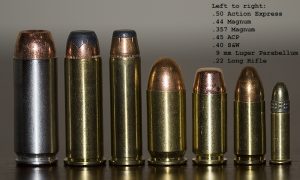SIG SAUER and Federal Premium Ammunitions introduced .357 SIG ammunition in 1994. The cartridge has a rimless, bottlenecked case. The companies wanted to have the same power as the .357 Magnum, but designed it for use in a semi-automatic pistol. The ammo was launched four years after the .40 S&W, a round created for the FBI. The .40 S&W has the stopping power of a .45 ACP and ease of use of the 9mm parabellum. Although the .357 SIG performed better than the .40 S&W, it never became as popular with law enforcement or the public.
.357 SIG Design
The designers took a .357 bullet and pared it down to .355-inch to make it easier to handle. The .357 SIG was the first commercial bottleneck ammunition sold since the 1960s. The cartridge base diameter is .424-inch, the case is .864-inch in length. The full length of the cartridge is 1.140-inches. It uses a bullet with 125-grains, the same as a .357 Mag. It has a velocity of 1,350 feet per second (fps), and muzzle energy of more than 500 foot pounds (ft·lbs). The round is also referred to as the .357 SIG, .357 Sig, and 9x22mm.
.357 SIG vs. .357 Magnum
Although the .357 SIG never became popular, it remains a favorite of some law enforcement agencies, as well as target shooters and those who are in range training or carry for self-defense. Unlike other small rounds, the .357 SIG has the ability to cause hydrostatic shock, immediately disabling or fatally wounding its target upon impact. While the .357 Magnum remains more popular, the .357 SIG still packs a punch. The smaller casing makes it optimal for self-defense.
Popular Firearms
Because of its lack of popularity, the .357 SIG has a limited number of firearms chambered for the ammunition. They include the full size SIG SAUER P226 (combat pistol), the compact 229, the 320 (designed for concealed carry), as well as a traditional 1911. Glock models include the full-size G31, compact G32, and G33, designed for concealed carry. S&W has discontinued their .357 SIG pistol from their M&P line.
Uses for the .357 SIG
Law enforcement agencies prefer the 9mm, but many still use the .357 SIG as a standard issue ammunition for the SIG SAUER and Glock pistols. The Texas Highway Patrol took it on in 1995, followed shortly by The Texas Department of Public Safety (DPS). The DPS used the .357 SIG as standard issue from 1998-2013. Other notable agencies include the Bureau of Industry and Security, Federal Air Marshal Service, The United States Secret Service, Pennsylvania Game Commission, and the Texas Rangers. It is also used by several state police troops and highway patrol units, including Mississippi, Montana, New Mexico, North Carolina, Oklahoma, Rhode Island, South Dakota, Tennessee, and Virginia.
Many experts refer to the .357 SIG as being obsolete but the fact that it is still used by so many law enforcement agencies shows that it has its place in the market.

